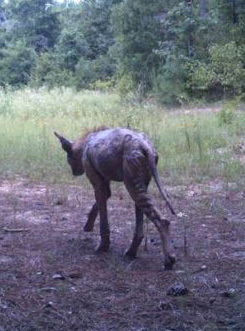
Positive ID made of animal shown on trail cam photo near Toledo Bend
The trail cam photo taken earlier this month east of Toledo Bend shows what almost looks like a small hyena, with big ears, very little hair, striped hocks and a furry neck.
When it was posted on the LouisianaSportsman.com Web site by user bmcgaha, comments and page views started adding up quickly.
Readers surmised it might be the mythical chupacabra, a thylacine or a coy dog, along with the relatively unexciting guess of a coyote with a bad case of mange.
So I forwarded the photo to Dr. Jim LaCour, state wildlife veterinarian with the Louisiana Department of Wildlife and Fisheries, for his expert forensic diagnosis.
Drum roll please …
And the winner is?
“That’s a mangy coyote in the picture,” said LaCour, whose keen insights into the two types of mange had me itching for the rest of the day.
So it wasn’t a rare, fleeting glimpse of a chupacabra, the mythical creature supposedly first seen in Puerto Rico that sucks the blood from its victims?
“I’ve never seen or heard of a real one being documented in the scientific community,” LaCour said with a chuckle. “I kind of doubt they really exist, but I guess you never know what’s out there.
“We’ve never seen one here. I’ll put it that way.”
So much for that. Now on to the mange. (I don’t want to be the only one scratching for the rest of the day.)
Demodectic, or red mange, is a hereditary condition caused by an immune deficiency that the animal has against mange mites, and can’t be transmitted to humans, LaCour said.
“The mites proliferate in the hair follicles, rupture the follicles, the hair falls out and they get secondary staph infections,” he said.
Sarcoptic, or common mange, is caused by a different mite and can be transmitted to other animals — including people, LaCour said.
“It is contagious, so it can be within a population or an area and spread to other groups of coyotes in that area,” he said. “They need to have direct contact or contact in areas where they bed.”
When people contract common mange, it’s called scabies, he said.
“The mite burrows into your skin and causes a severe reaction as it dies,” LaCour said. “It’s almost like a chigger bite on steroids. It makes you want to scratch constantly, and that’s what the dogs do.”
Since the symptoms from the two types of mange can appear identical, LaCour said he couldn’t tell from the photo what specific kind this coyote had, but he guessed that the animal had it for about three or four months.
“Hair loss can proceed very rapidly. It can go from an initial infection to this sort of hair loss within a month or two,” he said. “The longer it progresses, the thicker the skin gets and the more folds it gets.”
And what about the gray skin and dark stripes on the hind legs in the photo?
“That’s probably pigmentation from a staph infection,” he said. “Anywhere there is a crease or fold, there’s going to be some darker lines from staph proliferation in those areas. Their skin thickens like elephant skin, develops folds and gets gray and crusty.”
He didn’t think this animal would survive long in the colder months ahead.
“If it can’t find a burrow or somewhere to get out of the elements, it’s probably not going to make it through winter,” LaCour said. “That’s Mother Nature’s culling device.”
The number of trail cams has increased the number of suspected chupacabra sightings, which LaCour said come in pretty consistently about once or twice every month.
“With trail cameras out, everybody gets pictures of them,” LaCour said. “People have seen the chupacabra (cable television) specials, and they think they’ve killed a chupacabra. We look at a number of them under that premise, but they all end up being just mangy coyotes.”
Because common mange is transmissible to humans, LaCour recommended wearing gloves if you feel compelled to handle a coyote that has been shot.
There are no official stats, but from photos he’s seen and animals he’s examined, he figures mange is pretty common in the state’s coyote population.
“Maybe it keeps the population down on coyotes just a little bit, but they’re doing very well,” LaCour said. “They’re in rural areas, suburban areas and urban areas. They make a good living out there on the landscape. They’re pretty good at what they do, actually.”
So no luck this time on catching a glimpse of any mythical creatures up near Toledo Bend. But keep sending in those trail cam photos — and while you’re at it, pass me some calamine lotion.


